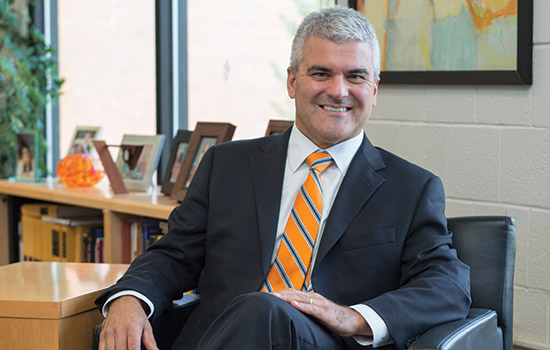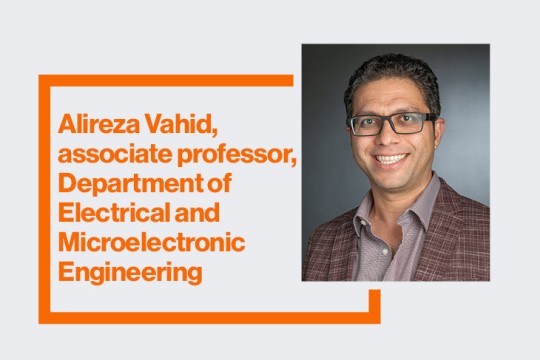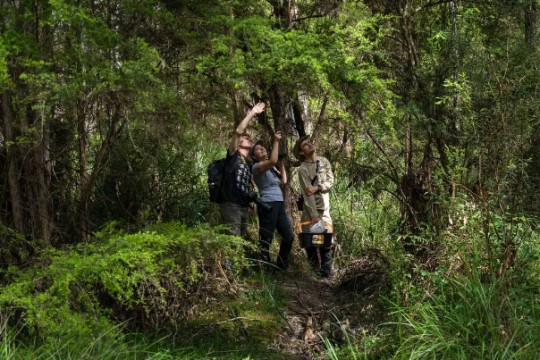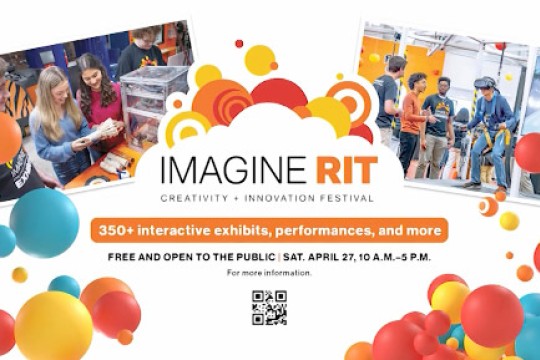Research in humanities and social sciences grows
Making a Difference: James Winebrake, dean of RIT’s College of Liberal Arts, encourages interdisciplinary collaboration to help students have an impact on the world and lead lives of consequence.
Humanities and social sciences research at RIT represents a diverse array of scholarship that includes work in traditional disciplines as well as interdisciplinary areas such as cybersecurity, personal health care, sustainability, cognition among individuals who are deaf, ethics within engineering, and studies to prevent crime.
Long-term Investment
Some people may be surprised by just how big a role the humanities and social sciences play in the education of students attending a university called Rochester Institute of Technology.
Even in its pre-RIT days when the Mechanics Institute added English to the curriculum in 1899, the board of directors felt that technical professional instruction alone did not constitute a complete education.
“The manual course which should be strong is weak inasmuch as it contains too much manual and too little mental work,” said the institute’s board of directors then, according to Dane R. Gordon, who wrote Rochester Institute of Technology: Industrial Development and Educational Innovation in an American City 1829-2006.
“The barriers between science, technology, and humanities have been eroded in the past years,” said Gordon, who joined RIT as a philosophy faculty member in 1962 and served as department chair and acting dean of RIT’s College of Liberal Arts before retiring in 2000. “Now, there are quite a lot of interdisciplinary studies encouraging social science, humanities, and technology students to work together.”
Research in these areas continues to grow as well.
Humanities are found in every college at RIT, including the National Technical Institute for the Deaf, where leading researchers study the way deaf and hard-of-hearing individuals comprehend information and communication.
More than $20 million in external funding from local, state, and federal agencies and foundations has been awarded to support research projects involving the College of Liberal Arts in the past five years. This year saw a record $5.43 million in external funding, said Dean James Winebrake. Additional support for research comes from within RIT in seed funding and research fellowships, which provide time for faculty to conduct research and develop proposals for external sponsors.
“Research in the humanities is a long-term investment in the future,” said Russell Wyland, acting director of the National Endowment for the Humanities’ Division of Research Programs.
“What we know about ourselves as a culture is the result of generations of scholars who have helped us understand our past. We are seeing more and more collaborative work being done that brings humanities insights and methods to fields such as medicine, science, technology, and the social sciences,” Wyland said. “This work is connecting disciplines together in exciting ways that will open up new perspectives in our past and future.”
Diverse Offerings
The importance of the humanities and social sciences at RIT has never been stronger, and strategic plans for the future education of students strongly encourages interdisciplinary collaboration among those studying liberal arts and those studying science, technology, engineering, and mathematics.
All of RIT’s baccalaureate students take courses in the College of Liberal Arts as part of their majors in all other colleges at RIT, and more than 20 percent of all student credit hours from all RIT undergraduates are taken in COLA classes.
More than 600 students are earning undergraduate degrees in one of the 14 majors offered at COLA: advertising and public relations, communication, criminal justice, digital humanities and social sciences, economics, human-centered computing, international and global studies, journalism, museum studies, philosophy, political science, psychology, public policy, and sociology and anthropology. Some of these majors, such as human-centered computing and digital humanities and social sciences, are offered in partnership with other colleges on campus. In addition, a new BS degree in applied modern language and culture was recently approved by New York state and will be enrolling students in the next academic year.
Social sciences and humanities research at RIT is as diverse as the courses offered. It includes scholarship in areas as varied as cybersecurity, personal health care, sustainability, human and animal cognition, engineering ethics, crime prevention, and new revelations on the histories of Love Canal, composer Joseph Haydn, and energy storage, to name a few.
Research is even being done now about last year’s presidential election for a new book titled Nasty Women and Bad Hombres: Historical Reflections on the 2016 Presidential Election.
Co-edited by Christine Kray, associate professor in the Department of Sociology and Anthropology; Tamar Carroll, associate professor in the Department of History; and Hinda Mandell, associate professor in the School of Communication, the book is made possible with a seed grant from the College of Liberal Arts and is under review with the University of Rochester Press.
“It will be a scholarly attempt to make sense of the 2016 presidential election looking at historical ties, gender, and racial themes through personal essays,” Mandell said.
Following Technological Advances
Research with evolving technology brings greater potential for new applications.
Prime examples are two signature research area grants, one involving cybersecurity with Josephine Wolff, assistant professor in the Department of Public Policy, and one involving personal health care with Assistant Professor Emily Prud’hommeaux and Associate Professor Cecilia Ovesdotter Alm, both in the Department of English. They are researching ways spoken or written language can help determine whether someone may have early-stage Alzheimer’s disease, be in a certain emotional state, or may be autistic and have unique communication needs.
Professor Jonathan Kruger, chair of the Department of Performing Arts and Visual Culture, is working with RIT’s College of Applied Science and Technology and College of Imaging Arts and Sciences on audio engineering and composing music for video games and films.
Beyond the Lab
Caroline DeLong, an associate professor in the Department of Psychology, has been conducting research on dolphins, whales, fish, bats, penguins, honeybees, and humans for 20 years on a variety of topics including visual and auditory object perception and tool use.
Her current research involves perception in North American river otters and tool use in Bornean orangutans at Rochester’s Seneca Park Zoo.
“I’m interested in understanding how animals experience the world,” she said. “They have a different set of sensory abilities than we do. They see and hear differently than we do.”
Her research can be used to inform conservation efforts. River otters are again swimming in Rochester-area waters after the zoo became instrumental in repopulating them in the region in the 1990s. Research DeLong is doing can be used in future conservation efforts for the otters. “We need to know more about their perceptual and cognitive abilities in case their population is threatened again,” she said.
DeLong is also involved in collaborative marine mammal research projects with colleagues in Florida and California.
DeLong is director of RIT’s Comparative Cognition & Perception Lab (www.rit.edu/DeLonglab), where one project is focused on long-term memory in goldfish. If the fish can differentiate between a circle and a square, it will get fed.
“The idea that fish have a three-second memory is a myth,” she said. “My fish can remember a visual task for more than three months.”
Several undergraduate and graduate students are also involved as research assistants.
“The research is also giving students a valuable experience they can carry with them, and some go on to attain a master’s degree or Ph.D. in psychology and other fields,” she said.
Interdisciplinary Collaboration
RIT’s Strategic Plan 2025 states RIT “will select, invest in, and foster interdisciplinary and trans-disciplinary research areas of focus where RIT’s assets align with growing opportunities.” The recent addition of a digital humanities and social sciences bachelor’s degree is one example.
“Research conducted in the College of Liberal Arts often reaches into other colleges at RIT,” Winebrake said. “The interdisciplinary culture here helps bring science, technology, and the liberal arts together. This interdisciplinarity creates a very positive influence on our students, who need to understand the important interconnections across disciplines if they want to have an impact on the world and lead lives of consequence.”
In February, RIT became the newest university designated as part of the Grand Challenge Scholars Program, a national initiative to train future engineering and non-engineering professionals to play a significant role in solving major challenges of the 21st century.
The National Academy of Engineering identified more than a dozen challenges that if solved through collaborations between individuals involved in science, engineering, and the liberal arts, could positively impact complex societal issues.
“Addressing global challenges—such as providing clean water or restoring urban infrastructure—requires understanding and analysis that goes beyond the problem’s technical dimensions,” Winebrake said. “To solve these problems, students need to understand not only advanced technology, but also the social, cultural, political, ethical, and economic dimensions of these problems. This program brings together engineering students and liberal arts students to work collectively on solving global challenges through innovative curricula and project-based work.”
Ryne Raffaelle, vice president for research and associate provost, is pleased with the mark RIT research is making in the field of the humanities and social sciences at RIT.
“It has been quite gratifying watching the steady increase in sponsored research awards over the last five years under Dean Winebrake’s leadership,” Raffaelle said. “The most dramatic increase has been in the number of COLA faculty who are serving as co-principal investigators on sponsored research awards being led by principal investigators across the entire campus.”
Currently, 23 COLA faculty members are principal investigators or co-principal investigators, compared to 14 in 2007.
And the benefactors of such research collaboration among colleges within RIT are the students, who will gain greater awareness and understanding of issues and solutions outside their primary majors, and will be more marketable after graduation when they start their careers.
“At RIT we have always strived to produce well-rounded students,” Raffaelle said. “For many, this implies a good grounding in liberal arts and social sciences. The collaborative research relationships formed by our faculty in liberal arts with our other colleges ensure that we are offering well-rounded educational experiences for our students outside the traditional classroom for years to come.”
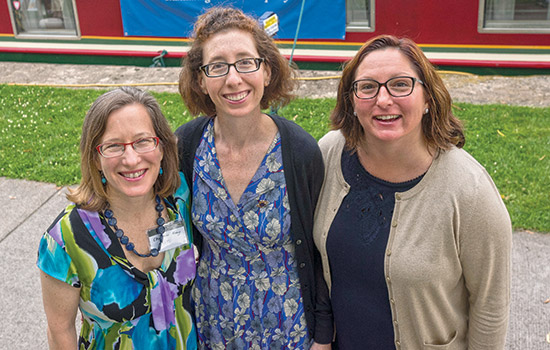 Documenting History: Christine Kray, left, associate professor in the Department of Sociology and Anthropology; Hinda Mandell, center, associate professor in the School of Communication; and Tamar Carroll, associate professor in the Department of History, are collaborating on a book about the 2016 presidential election.
Documenting History: Christine Kray, left, associate professor in the Department of Sociology and Anthropology; Hinda Mandell, center, associate professor in the School of Communication; and Tamar Carroll, associate professor in the Department of History, are collaborating on a book about the 2016 presidential election.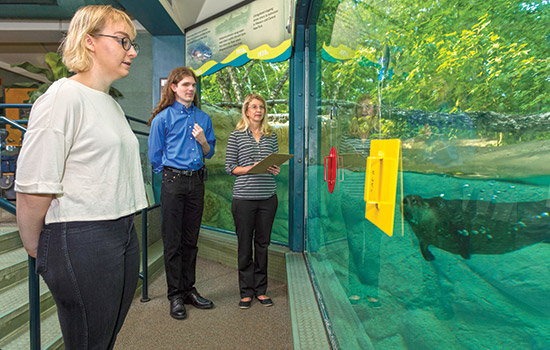 At the Zoo: Caroline DeLong, an associate professor in the Department of Psychology, has been doing comparative cognition research at RIT for more than 10 years, including working with North American river otters for more than five years. DeLong, with clipboard, conducts tests with Sara the otter at Rochester’s Seneca Park Zoo with fourth-year psychology students Henry Rachfal, center, and Kathryn Gardner, left.
At the Zoo: Caroline DeLong, an associate professor in the Department of Psychology, has been doing comparative cognition research at RIT for more than 10 years, including working with North American river otters for more than five years. DeLong, with clipboard, conducts tests with Sara the otter at Rochester’s Seneca Park Zoo with fourth-year psychology students Henry Rachfal, center, and Kathryn Gardner, left.










